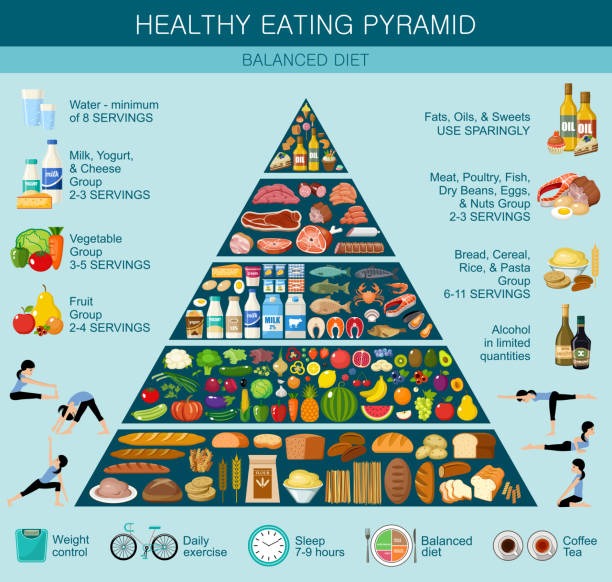Breaking Down the USDA Food Pyramid: What You Need to Know Today
The USDA Food Pyramid was once the cornerstone of American dietary guidance. But as nutrition science evolves, so do the recommendations. This blog explores the history of the Food Pyramid, its impact, and the modern approach to healthy eating that has replaced it.
DipVai
11/26/20243 min read


For decades, the USDA Food Pyramid was a familiar symbol in classrooms and kitchens across America. Introduced in 1992, it served as a guide for balanced eating, encouraging people to consume a variety of food groups in specific proportions. However, as our understanding of nutrition has advanced, so have dietary recommendations. The Food Pyramid has since been retired and replaced with more effective tools, but its legacy remains a topic of discussion.
Here’s a closer look at the Food Pyramid, why it was replaced, and what you need to know about modern dietary guidance.
The Original USDA Food Pyramid
The 1992 Food Pyramid was designed to help Americans make healthier food choices. It was divided into six sections:
Grains: Represented the base of the pyramid, with a recommendation to consume 6–11 servings per day.
Fruits and Vegetables: Occupied the second tier, with a combined focus on eating 5–9 servings daily.
Protein and Dairy: These food groups included meat, beans, and dairy products, suggesting moderate consumption.
Fats, Oils, and Sweets: At the top of the pyramid, this section advised using these sparingly.
While the pyramid was simple and visually memorable, it had significant flaws. Critics argued that it emphasized carbohydrates too heavily, lumped healthy and unhealthy fats together, and lacked clarity on portion sizes and food quality.
Why the USDA Food Pyramid Was Replaced
By the early 2000s, the Food Pyramid faced growing scrutiny from nutrition experts. Research revealed that its recommendations didn’t align with the latest understanding of healthy eating. Key criticisms included:
Overemphasis on Grains: Encouraging up to 11 servings per day led to excessive carbohydrate intake for many, potentially contributing to weight gain and metabolic issues.
Oversimplification: The pyramid grouped foods in ways that didn’t differentiate between healthy and unhealthy options (e.g., whole grains vs. refined grains).
Lack of Customization: The pyramid provided the same guidelines for everyone, ignoring individual needs based on age, gender, activity level, and health conditions.
Introducing MyPlate: A Modern Approach
In 2011, the USDA replaced the Food Pyramid with MyPlate, a simpler, more flexible visual representation of a healthy plate. MyPlate emphasizes portion control and balance, breaking food groups into more practical guidelines:
Half the Plate: Fruits and vegetables.
One Quarter: Whole grains.
One Quarter: Lean protein sources.
A Side of Dairy: Encouraging low-fat or non-dairy alternatives.
Why MyPlate Works Better:
Focus on Portion Sizes: MyPlate is easier to visualize and translate into meals.
Quality Over Quantity: It highlights the importance of nutrient-dense foods like whole grains and lean proteins.
Customization: MyPlate can be tailored to individual dietary preferences, such as vegetarian, vegan, or low-carb lifestyles.
What You Need to Know Today
Modern dietary advice goes beyond visual guides like MyPlate. Here are some updated principles to help you make informed choices:
1. Focus on Whole, Unprocessed Foods: Nutritionists emphasize consuming foods in their most natural state, such as fresh fruits, vegetables, whole grains, nuts, and seeds. Limit ultra-processed foods high in added sugars, sodium, and unhealthy fats.
2. Embrace Healthy Fats: Unlike the original pyramid, modern guidance recognizes the importance of healthy fats. Include sources like avocados, olive oil, nuts, and fatty fish in your diet.
3. Personalize Your Diet: Everyone’s nutritional needs are different. Factors like age, activity level, and medical conditions play a role in determining what’s best for you.
4. Limit Added Sugars and Sodium: The Dietary Guidelines for Americans recommend limiting added sugars to less than 10% of daily calories and watching sodium intake to reduce the risk of chronic diseases.
5. Hydrate Wisely: Water should be your primary beverage, with limited consumption of sugary drinks or alcohol.
Building Your Plate: A Practical Guide
When planning meals, think of MyPlate as your framework:
Breakfast: Oatmeal topped with fresh fruit and a dollop of almond butter, with a glass of low-fat milk or plant-based alternative.
Lunch: A colorful salad with mixed greens, grilled chicken, quinoa, and a drizzle of olive oil-based dressing.
Dinner: Grilled salmon with roasted sweet potatoes and steamed broccoli.
Snacks: Raw veggies with hummus, a handful of nuts, or a piece of fruit.
Conclusion
The USDA Food Pyramid served its purpose in promoting dietary awareness, but as science evolved, so did the tools we use to guide healthy eating. MyPlate and modern nutritional principles prioritize simplicity, flexibility, and the quality of food over rigid servings.
By embracing these updated guidelines, you can create a sustainable, balanced diet that supports your health and well-being. Whether you’re looking to lose weight, manage a health condition, or simply feel better, understanding the evolution from the Food Pyramid to today’s recommendations is key to making better choices for a healthier future.
Image: istock
Get in touch
itsusdipvai@gmail.com
